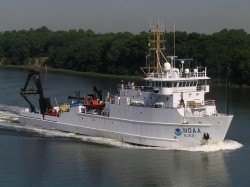BOEMRE, NOAA and USGS Launch Maritime Science Expedition off Mid-Atlantic Coast Aboard the Research Ship Nancy Foster

The Bureau of Ocean Energy, Regulation and Enforcement (BOEMRE), the National Oceanic and Atmospheric Administration (NOAA), and the U.S. Geological Survey (USGS) today announced that a multi-agency team of ocean scientists has launched an expedition [through the National Oceanographic Partnership Program] using sonar to map deepwater canyons, and to identify sensitive biological habitats, coral communities and archeological sites such as shipwrecks and other historically significant sites.
(From NOAA) –This cooperative effort to gather information for science-based decision making is consistent with the National Policy for the Stewardship of the Oceans, Our Coasts and Great Lakes, adopted by President Obama in July 2010.
Through a process called echo-sounding, technicians are using sonar aboard the ship to generate 3-D bathymetric seafloor maps. These maps will allow scientists to identify features on the seafloor to be investigated over the next two years during follow-on expeditions. Bathymetry refers to measuring the ocean’s depths.
The team sailed on June 4 from Charleston, S.C., aboard NOAA Ship Nancy Foster to an area about 100 miles off the coast of Virginia and Maryland where the canyons are located.The expedition ends on June 17, and is the first of several in a joint-agency partnership over the next three years. Total funding for the three-year study is approximately $9 million, shared equally among the three agencies.
The expedition is conducted through an interagency agreement as part of the National Oceanographic Partnership Program (NOPP). NOPP involves BOEMRE, NOAA and USGS and maximizes the use of federal resources, such as human capital, ships and equipment at reduced costs, while meeting national priorities and advancing specific scientific missions of the agencies in partnership.
BOEMRE’s Environmental Studies Program provides the information needed to predict, assess and manage impacts from Outer Continental Shelf offshore oil and gas, marine minerals, and renewable energy exploration, development and production activities on human, marine and coastal environments.
Commemorating 10 years of ocean exploration, NOAA’s Office of Ocean Exploration and Research uses state-of-the-art technologies to explore the Earth’s largely unknown ocean in all its dimensions for the purpose of discovery and the advancement of knowledge. NOAA’s mission is to understand and predict changes in the Earth’s environment, from the depths of the ocean to the surface of the sun, and to conserve and manage our coastal and marine resources.
USGS involvement will lead to discovery of timely, relevant, and impartial information about the landscape, our natural resources, and the natural hazards that threaten us, focusing on biology, geography, geology, geospatial information, and water.
Follow the expedition at: http://oceanexplorer.noaa.gov/explorations/11midatlantic/welcome.html
Additional information about BOEMRE’s Environmental Studies Program is available at http://www.boem.gov/studies/
Further information about NOAA is available at: http://www.noaa.gov
Further information about USGS is available at: http://www.usgs.gov



